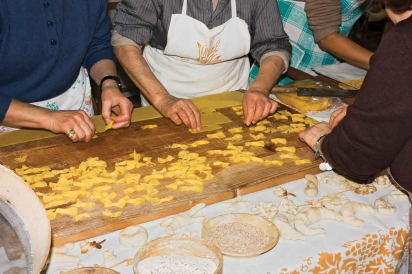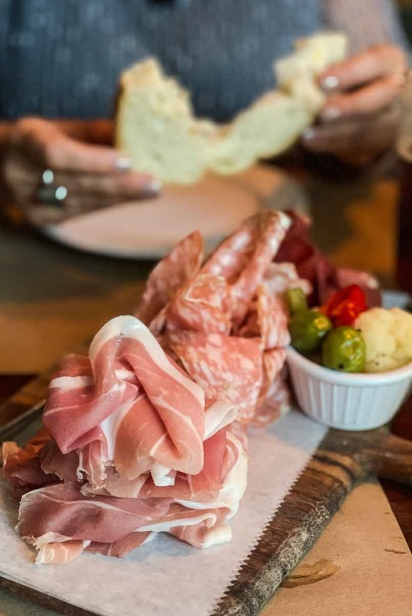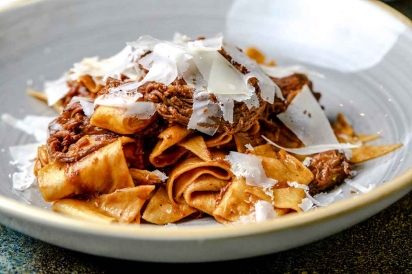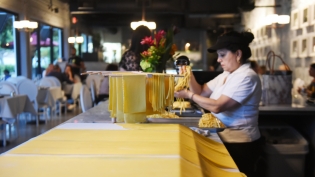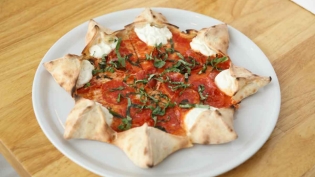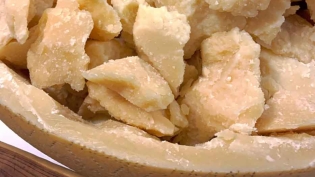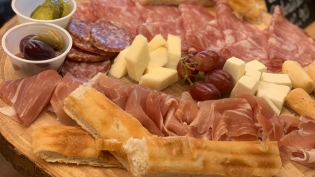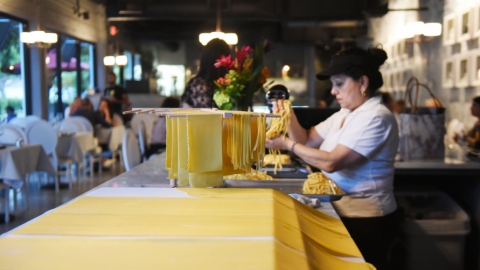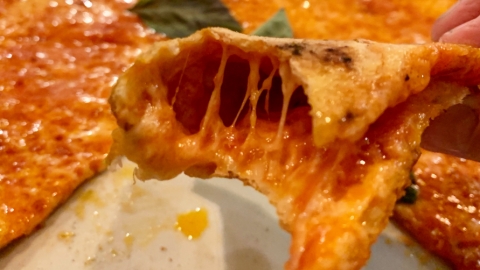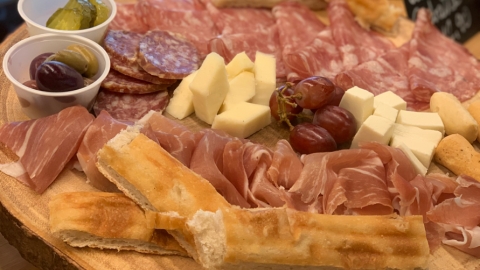A tavola – The quest for Italian food in South Florida
Spaghetti and meatballs? Pizza? Lasagna? Or do you imagine polenta with sausage, or a tender slice of chicken enveloped in a soft coating of golden breadcrumbs, not quite a crust but something enrobing and flavorful, that adheres just so, like a favorite sweater?
All of the above are undoubtedly Italian-ish. More about that later.
Here’s what I conjure: a dense, rich, satisfying minestrone my mother made in the winter months. Like the unlikely marriage that somehow works, this ambrosial concoction had a base of borlotti beans (the prettiest of beans: chocolate brown laced with bright pink and flecks of green) that had been softened overnight, ham hocks browned in a delicate roux and scented with bay leaf, pancetta with a very healthy percentage of fat, potatoes, garlic and ... sauerkraut. Lots of sauerkraut, imbionditi, (“blondened”) as my mother would say, in olive oil and garlic, and added towards the end. This minestrone, which can take about three to four hours of serious attention, is called jota (pronounced YO-tah) and is typical of the geographical area at the top-right corner of the boot.
I can’t call it a region, because it comprises a city — Trieste – beautiful, on a wide Adriatic bay, and at the foothills of the Alps – and a territory that used to be part of Italy and is now divided between Slovenia and Croatia. My parents both grew up in that area, as did I. I’m actually an example of reverse migration. After being buffeted about in the winds of war, my parents came to the U.S. through the auspices of the International Refugee Organization after WWII. They had four children and were worried about the future and chose, reluctantly, to leave their beloved Istria for upstate New York.
The adjustment was difficult. There was an Italian community, but as any paisano can tell you, there really is no such thing as “Italy.” Instead there are regions, and within those regions there are cities. Italy is comprised of 20 regions, each with its own complex history of domination, rebellions, languages and culinary influences. Venice, an important trading post and a financial powerhouse from the 13th to the 17th centuries, absorbed gastronomical influences from the Ottoman Empire, North Africa and the neighboring regions. Built on 118 small islands, Venice is home to a cuisine redolent with the aromas of the sea, but also flavored with cinnamon, candied fruits and eggplant. The specialties of Trieste, the major port of the Austro-Hungarian Empire, include many dishes that don’t conjure “Italianity” to most visitors: hearty stews, strudels, pickled vegetables. Beautiful Calabria, with its rugged coastlines and arid interior landscapes, emphasizes the spicy peppers and the fragrant wild black anise seed that grow in abundance in the region. That said, Italians also have as many words for pasta types as Greenlanders have for snow. Even we “polentoni” from the North love our specialty pastas, and not a week goes by without a some sort of cavatelli, canizei, cavatappi, or strozzapreti on our plates. Pasta is our great unifier, as important as our beloved Garibaldi.
So Many Foodways
There are 20 regions in Italy, and within these many municipi, or municipalities, microcosms within microcosms, each characterized by different landscapes, dialects and most importantly, foodways. Some regions flavor their sauces with selvaggina, or wild animals. Others make a tender salad of what appears to be blades of grass. One person’s bread dunked in fresh tomato sauce is another’s polenta with sausage and mushrooms. And so my parents had to make do and adapt their Istrian palate to the groceries available in their small upstate town, which was populated primarily by Italians from the Abruzzi and Calabria regions. Their dialects differed wildly, and their food, well ... it was a case of “you say rigatoni, I say risotto.” Still, thanks to the unifying and joyful nature of food, recipes were shared, new flavors were adopted, and Signora Pierina learned to make polenta while my mother learned pizza secrets from Signora Gualtieri. Eventually, however, they returned to Italy, with me, a late addition to the family, in tow. I returned to the U.S. as an adult, and, like my parents during their exile, have been searching for the flavors of home ever since.
Italians from Italy are food snobs and also food partisans. Anyone who gets too foofy about their regional dishes sooner or later has to stand in the pretentiousness corner. Not even the finest chefs stray too far from the original tastes championed by the true standard-bearers of Italian cuisine: the mamme and the nonne. It is these women who are the custodians of that particular Italian umami we call sapore. “Ma che buon sapore! Che saporito!” are two of the finest compliments an Italian hostess or host can receive. “Sapore” means flavor, but it implies quality, and the tiny nuances, so very elusive, that make up the thousands of varieties of true Italian gastronomy. It means the sweet richness of a paper-thin slice of prosciutto from San Daniele or the fragrant flecks of lemon rind in a piece of ricotta pie. It’s the slow, slow, slooooooow simmering of a perfect tomato sauce with just the right amount of oregano. Sapore implies lessons learned from watching someone in the kitchen over decades, and using the very best ingredients at the peak of their freshness. It encompasses the antiquity of a country that has seen it all, and has become adept at shrugging and saying “allora, cari, tutti a tavola.” To the table, let’s eat and drink. We’ll worry about the rest of this stuff tomorrow.
Searching for Sapore
So how can one find sapore in South Florida? It’s not easy. There is plenty of Italian food to be had, and the chefs are Italian, but often by way of Argentina, Venezuela, Cuba or Brooklyn. This is all good. The melting pot is also a mixing pot, and cuisine is constantly evolving everywhere. But an Italian from Italy often seeks and does not find that special sapore that transports them back to Trieste, or Bari, or Nuoro in Sardegna. They seek that particular contrast of fresh baby peas against the savory parmigiano in risi e bisi, or the earthy robustness of a wild boar stew flavored with sage the poor boar had trampled mere hours before its demise. They seek the crackly sound a perfect pizza crust makes before you get to the chewier interior. They seek nonna’s patience and the flavors of local vegetables and fruits sold at markets, where the merchants are as proud of their wares as they are of their children.
When I first moved to Miami, I despaired of finding authentic regional Italian food. Menu items were egregiously misspelled. Pasta types didn’t marry well with their accompanying sauces. There was too much sugar, too little reduction and gigantic portions that prized volume over quality. This was not nonna’s food. It wasn’t even 21st century work-harried Italian lady or guy food. This was “all’Americana,” as mamma Gisella would sigh. Which didn’t necessarily mean bad. It just meant “not real.”
I’m happy to say that times are changing. There are some very, very good restaurants in our fair city that are getting it right and carrying the torch of Italian regional authenticity. And as in Italy, fancy does not equal better. One of my favorite pizzerias in Miami – indeed I think it equals some of the buzziest pie shops in the country – is Capri New Style Ristorante Pizzeria on 71st St. in Normandy Isle. There, chef Massimiliano Stamerra and his team produce a pizza with a crust so superlative that toppings are almost not needed. Turn over the crust and tap on the bottom to see what I mean. Stamerra, from the town of Racate in the province of Lecce, Puglia, has been a four-time winner at the Pizza Expo in Las Vegas.
In Midtown and Coral Gables, Salumeria 104 brings the charms of a Northern Italian trattoria that specializes in what we call salumi – cured meats – and well-chosen cheeses. Again, simplicity equals elegance of flavor; seasonal trumps fashionable, and quality reigns. Their charcuterie boards shine, as do their pasta dishes. Often the “proof in the pudding” dish for me, when it comes to regional authenticity, is gnocchi. Salumeria 104 serves gnocchi alla Romana, that regional specialty made with semolina and rich with butter and Parmigiano Reggiano, rather than the better-known potato gnocchi.
New + Old
Milanese cuisine shines bright in Vista in the new Upper Buena Vista complex just north of the Design District. Restaurateur Roberto Bearzi, together with his Costa Rican wife Fiorella Blanco and his twin brother Emanuele, have created a restaurant that successfully blends that Miami brand of cha cha with a bit of mambo Italiano. Vista resembles a homey yet hip Milanese restaurant that has been transported to the tropics. An idyllic rooftop terrace seduces with containers filled with tropical plants and olive trees, but it’s the food that seals the deal. After honing his skills at fine Italian restaurants, Bearzi traveled through Europe, the U.S., and Central America, adapting traditional Italian cuisine to respectfully take on new flavor notes from the locales he visited. The result: a series of dishes that marry the best of Italian home cooking with a cosmopolitan flair that never diminishes its original sources.
If there’s one unifying note in the gorgeous crazy-quilt of cuisines that is Italy, it is The Vegetable. Italians love, love, LOVE their vegetables. The gauge of authenticity in any Italian meal is the humble insalata, or side salad. No mere jumble of romaine or iceberg burdened with glops of dressing, an Italian salad is always fresh, crunchy, sometimes a bit spicy, surprising – bitter escarole with thin slices of fennel, anyone? – and as perfectly dressed as any Italian diva. This means the absolute right amounts of high-quality olive oil, the perfect vinegar, and just-so calibrated salt and pepper. And basta.
I’m happy to say that Vista’s salad really brought me back to my Italy. I was sitting in our bright Miami sun and under our glorious clouds, but I could smell the cypresses and laurel trees on the slopes of the Triestine hills. I was, briefly, home again. Buon appetito, ragazzi.



